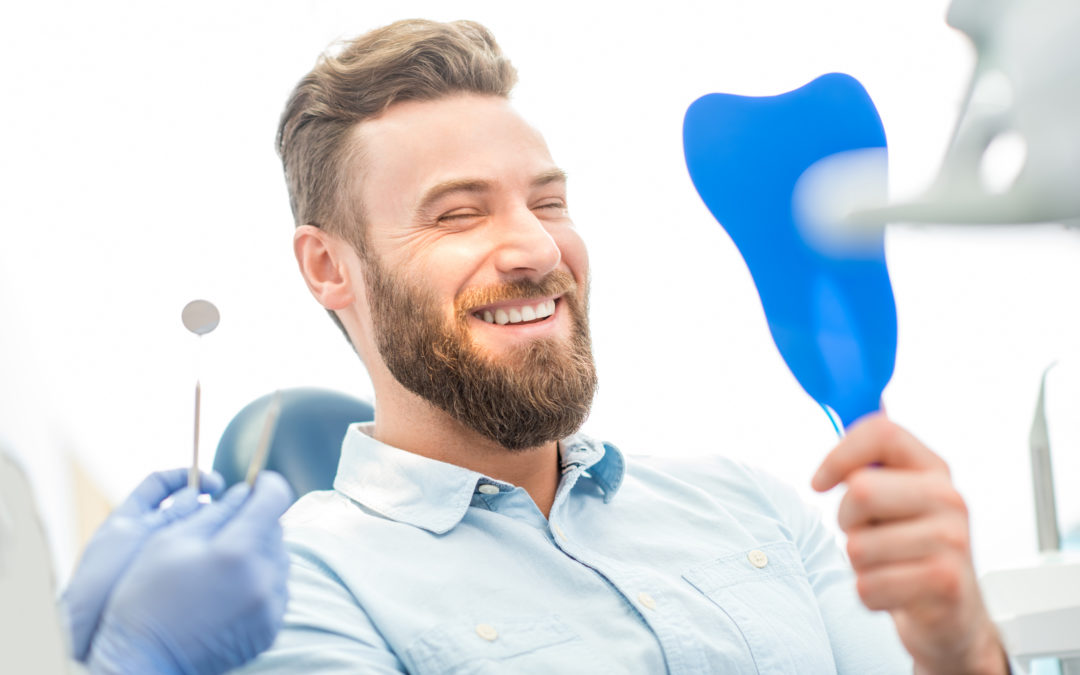There are basically three distinctly different types of discomfort that can be felt when, or immediately after, teeth whitening.
1. Pain from use of whitening lights and lasers.
First of all, as nearly all dentists understand, lights and lasers do virtually nothing to enhance teeth whitening. It’s all about science. As an example, I lectured a number of times in Europe back in 2004 and 2005. One time I was speaking to an audience of over 300 dentists in London, and I asked for a show of hands by dentists who believed that whitening lights and lasers are of NO USE. Virtually every dentist in the audience instantly raised their hands. So you can see that, even over in Europe, for many years, nearly all dentists have known that lights and lasers do nothing to further whitening results. The companies that push lights and lasers to sell their products still claim that the energy from lights and lasers increases the effectiveness of the whitening gels. But that is absolutely false.
The breakdown of peroxide in whitening gels is what we call an “exothermic” reaction, which means that the breakdown process (which is necessary to whiten teeth) MUST get rid of energy for the reaction to proceed. Le Chatelier’s Principle of Chemical Equilibrium clearly points out that trying to force energy (such as photon energy from lights or lasers) into an exothermic reaction that is trying to get rid of energy will not benefit the reaction, and could even impede this breakdown reaction.
But since consumers read all the fluffy marketing hype online, they call their dentist and ask if they use bleaching lights or lasers. So this sorta forces dentists to use these contraptions on their patients because patients often demand it.
But here’s the problem: Research has clearly shown that when you combine a high concentration hydrogen peroxide whitening gel, such as used inside a dental office, in addition to lights and lasers, this stimulates the secretion of something called “Substance P” inside the pulp of the teeth (nerve of the teeth). This Substance P is a neurotransmitter that causes pain in your teeth – often very strong, acute pain.
Of course, KöR Whitening does not utilize any light or laser, so this type of pain is eliminated 100%.
2. Generalized discomfort from teeth whitening
This is the most common type of discomfort from teeth whitening. Areas of your teeth, or even nearly all of your teeth, simply ache. It may be mild to intense. It may have a pounding throbbing sensation. The discomfort may or may not be triggered by cold drinks or food.
This discomfort is thought to be due to what we call dentinal hypersensitivity. Take a look at my illustration below. The main structure you see is what we call the dentin of the teeth. This is the structure you find often near your gumline. You see the little gray tubes (dentin tubules) leading from the red pulp (nerve) of the tooth, to the outside of the tooth. But you also see the brown “Smear Plugs” that have formed in the outer openings of the dentin tubules. This is very technically tartar buildup inside the outer orifices of these tubules.
Having these smear plugs plugging up the entrance to these dentin tubules is very important, and a VERY GOOD thing. Those smear plugs prevent sensitivity.

But when whitening, the cleansing force of peroxide is so effective that, in addition to helping whiten our teeth, it also can remove some of the smear plugs like you see below.
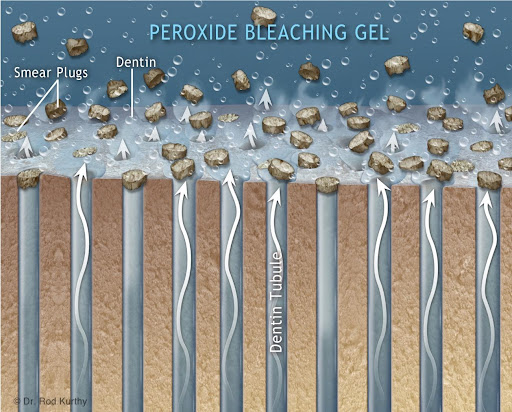
You’ve heard of the term “osmosis”. What that means is that when you have two different liquid-y substances next to each other, the stronger substance pulls on the weaker substance.
Well, the whitening gel is stronger (higher osmolality) than the fluid inside the dentin tubules. So the whitening gel “pulls” on the fluid inside the dentin tubules. In my illustrations above and below, you see the arrows inside the gray Dentin Tubules showing how the fluid inside the Tubules is being pulled outward.
In my illustration below, you see that the smear plugs are gone. You see the Dentin Tubular fluid being pulled out of the Tubules by the STIMULUS (which in this case is high osmolality whitening gel). Next look at the cells lining the pulp/nerve of the tooth called Odontoblasts. Notice how the little fingers of the odontoblasts are now being sucked up into the dentinal tubules. This then triggers the A-Delta Nerves in the pulp/nerve of the tooth, causing inflammation and generalized discomfort.
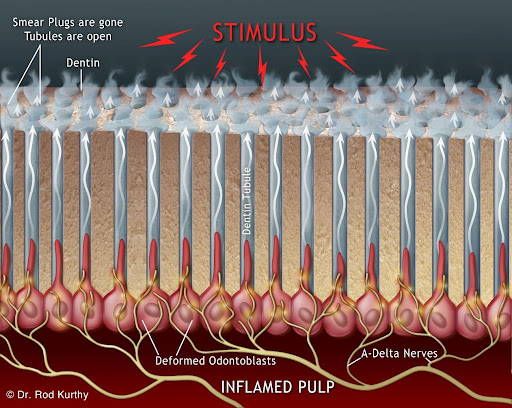
KöR Whitening deals with this in two distinctly different ways to reduce sensitivity/discomfort.
FIRST – KöR Whitening gels are refrigerated from the instant of manufacture until the instant of being used on your teeth. This means that we can use whitening gels that are 100% aqueous in nature. The refrigeration also prevents premature breakdown of peroxide and the formation of acid. This gets very technical, but suffice to say that the result is a significantly lower osmolality, and far less osmotic “pull” on the Dentin Tubule fluid. Therefore, less or no sensitivity.
SECOND – KöR Whitening is the only whitening system with a separate calcium phosphate desensitizer used by the dental office, and also used by you, the patient, every day at home.
Below you see a photograph taken through a Scanning Electron Microscope (SEM) at the University of Buffalo School of Dental Medicine showing a Dentin Tubule that has lost its smear plug. I have used blue color to represent the harder mineral structure of the Dentin Tubule so you can see it more easily.
Next, below you see another SEM showing some Dentin Tubules. These tubules had also lost their smear plugs, and were treated using the KöR Complete Desensitizer. Notice all of the white mineral that is now pugging the previously open Dentin Tubules. This means that, since these tubules are now plugged, the whitening gel is prevented from pulling on the Dentin Tubule fluid at all.
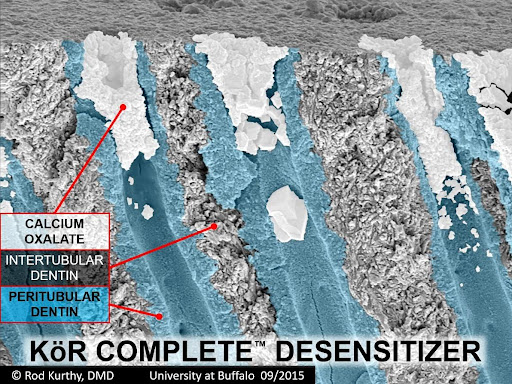
The KöR Complete Desensitizer plugs Dentin Tubules INSTANTLY when applied to the teeth. It is an all-natural product derived from various vegetables, such as spinach. It has no taste, and has never had any reported negative effect.
When combining the two methods KöR uses to reduce/prevent generalized teeth whitening sensitivity, you can see why it is so very effective in reducing and eliminating whitening sensitivity.
3. Zingers
If you’ve ever experienced what is called “Zingers” during or immediately after whitening, you’ll never forget it.
Here’s what you feel: You may or may not be feeling any generalized discomfort from whitening, and then all of sudden, out of nowhere, ZAP!!! A lightning bolt goes straight down through one of your teeth, nearly bringing you to your knees, and about 2-4 seconds later it’s gone. Poof. Gone.
But then, either seconds or minutes later, the same thing happens, usually in the same tooth. And this could be happening on one of your teeth, or 2-4 or your teeth, over and over again. But always in the same teeth.
This is the discomfort that dentists and patients fear the most. So first, what causes these Zingers? To my knowledge, I am the only person who has offered a formal, published theory.
Notice that I said this is my “theory”, and not my “hypothesis”. A hypothesis is simply an assumption of why something happens, with no concrete evidence. However, a true “theory” is based fully in science, with concrete evidence (facts) to support it.
Below you see my illustration showing whitening gel on the tooth surface. You also see an aberration through the enamel and dentin of the tooth, leading directly into the tooth pulp/nerve.
You see hydrogen peroxide (H2O2) having gotten into the pulp, and you see a Catalase Molecule inside the pulp/nerve of the tooth react with the peroxide and create a oxygen (O2) bubble instantly.
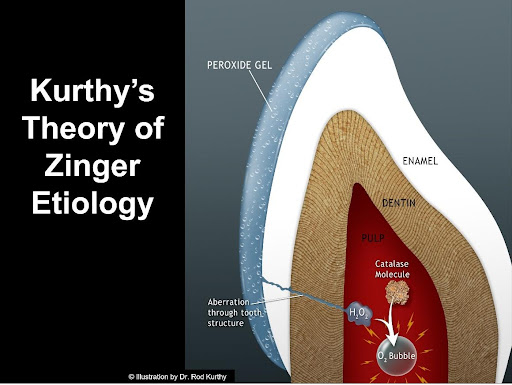
FACT #1: It has been proven that, due to various types of aberrations in tooth structure, peroxide always gets into the pulp/nerve of the tooth within 15 minutes of the start of whitening.
FACT #2: The antioxidant enzyme Catalase is present in all tissues of the body, including the pulp/nerve of the teeth.
FACT #3: When peroxide comes in contact with Catalase molecules, the peroxide is forced to instantly break down to oxygen (O2) and water.
FACT #4: When oxygen forms inside liquids and inside the tissues of the body, it instantly forms bubbles. Let me give you an example of this, which you may have seen before:
As a child, you may have fallen and skinned your knee, or otherwise cut yourself. So Mom pours a little hydrogen peroxide on the scrape/cut. It stings, and you see it bubbling. It is bubbling because the peroxide is coming into contact with Catalase enzyme in your blood and in your scraped/cut tissue. The Catalase molecules cause the peroxide to break down to oxygen, creating the bubbles.
FACT #5: Tooth structure is rigid and incapable of expanding, so when a bubble would form inside the pulp/nerve of the tooth, this would instantaneously result in a great spike of pressure inside the tooth in the pulp/nerve.
FACT #6: Pascal’s Law of Physics states the internal pressure of a “closed system” (like the inside of a tooth) will be constant throughout the closed system (pulp). This means that everything inside the pulp/nerve of the tooth would have exactly the same pressure spike at the same time.
FACT #7: The pressure spike would distort and trigger the pain nerves within the Pulp simultaneously.
FACT #8: Research has shown that when multiple nerves are triggered simultaneously, the sensation felt is like an electric shock – which is exactly what is felt with Zingers.
FACT #9: The tips of roots of teeth each have a very tiny opening called the Apical Foramen. This hole will allow the escape of the pressure spike over the period of 2-4 seconds.
You can see how the above proven scientific facts provide empiric proof of this Theory of Zinger Etiology, and why it has become the accepted theory by many in dental science.
HOW DOES KöR DEAL WITH PREVENTING ZINGERS?
The KöR Complete Desensitizer discussed and shown previously has also been shown by the University of Buffalo in SEMs to block/seal various types of enamel aberrations, which would effectively prevent any, or as much, peroxide from entering the pulp in the first place.
I hope all this information has not been overwhelming. The full lecture about this is about three hours, but I didn’t want to put you to sleep. 😉

